Phone Manager Admin User Guide
Discover how to manage and customize your phones to meet your organization's needs.
Table of Contents
Access Phone Manager
To access Phone Manager to make changes…
- Log into Stratus.
- Visit the Inventory page of Stratus.

- Click the Phone Hardware tab to view your phones.

Use the Phone Manager Launcher
To customize the layout of these phones, click on the Phone Manager button OR click on the arrow to the right to access the drop-down options.
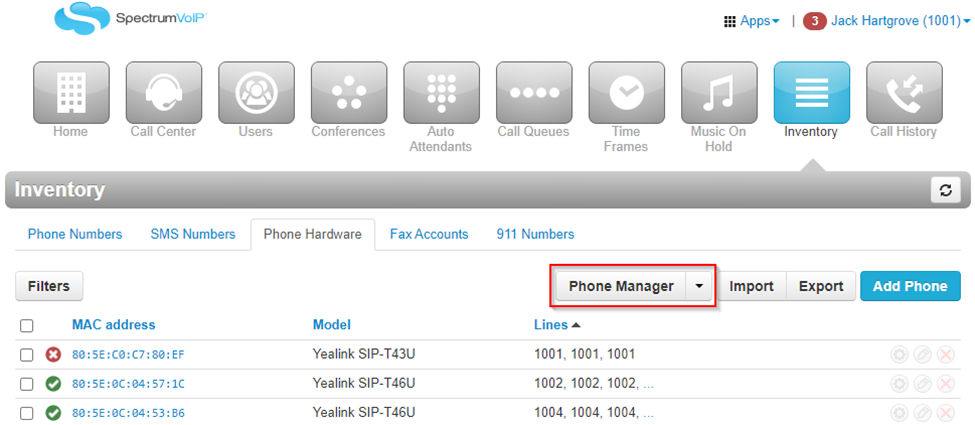
Clicking the Phone Manager button will show you two different ways to edit phones: Edit Phone Configurations and Edit Configuration Template. 
-
Edit Phone Configuration: Search for a specific phone to edit its button configuration.
- Enter a MAC address or the extension number of the phone you want to edit.
- Edit Configuration Template: Choose a phone model's template from the drop-down to view and adjust it.
Access Phone Manager for a Specific Phone
When a device is listed in the Inventory with an active device profile, you can click the MAC address to access Phone Manager.

Alternatively, you can click the Phone Manager  button to go to a particular device’s editor page.
button to go to a particular device’s editor page.
Access Phone Manager as a Basic User
Basic users can access the button configuration for their devices via the Phones tab.
To edit their phone's layout, users would…
- Click the Phone Manager
 icon.
icon.
✔ Doing so will pop up a confirmation message:

- Click the Yes button on the confirmation message.
✔ The Basic User will be shown a limited access view to their device.
- From here, basic users can edit their line keys, select their phone's directory source, and apply templates.
WARNING: For Basic Users, any buttons that have been locked will not be able to be edited. Line Appearance keys will be locked by default. Basic Users will also be unable to edit or add new templates.
Edit a Phone's Configuration
While you are in the Phone Manager page for a phone, you can edit a phone's button layout and change the source for its Directory.

Customize a Phone's Buttons
To edit a phone's button configuration…
- On an empty line key spot, use the Select a Feature drop-down select a feature for that line key.

Line Key Feature Options
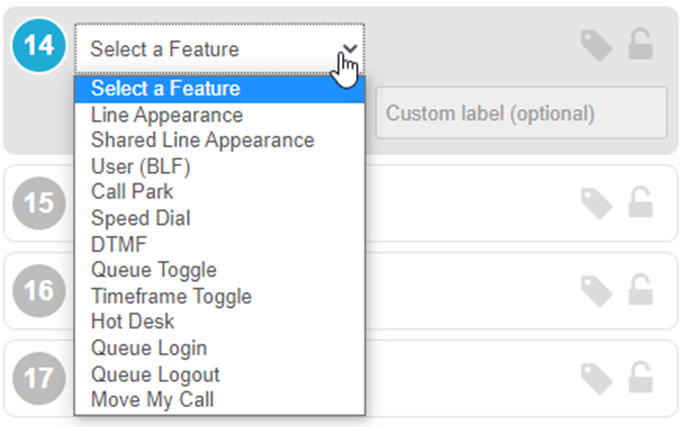
Feature Description Line Appearance Adds a line registration to the device and acts as a channel of communication that allows for multiple calls to be handled at once. Some features, such as transfers and conferences, require at least two line appearance keys. Shared Line Appearance Adds a shared line registration that can be shared by multiple devices. User (BLF) Press this key to quickly call or transfer a call to a coworker. The light allows you to see the presence status of another extension. Speed Dial Press this key to quickly call or transfer a call to a specific destination. This key can be used to contact external telephone numbers and other internal users. Call Park Allows you to park and retrieve an active call, based on your Call Park Queues and Dial Translations. DTMF Use mid-call DTMF features such as star codes.
Note: This feature is not supported by Cisco and Poly IP devices.Queue Toggle Quickly toggle your queue availability status between Available and Unavailable.
Note: Indicator lights may not work on some devices.Timeframe Toggle Toggle a specific time frame on and off for your user. This timeframe must be on the Answering Rules of the user of the phone. Indicator lights may activate on applicable devices. Hot Desk This version of Hot Desking is not recommended.
If you would like to utilize a hot desk set up, please reach out to SpectrumVoIP’s Technical Support team.Queue Login Log into all call queues that you are assigned to. Queue Logout Log out of all call queues that you are assigned to. Move My Call Move a call that is currently active for your user to this device, such as from the SpectrumVoIP Mobile App, the StratusHUB desktop app, or the Stratus Web Phone. - If needed, click the Lock icon to lock a line key to prevent it from being edited by Basic Users.

- Add a Custom Label to change the name displayed by a line key.
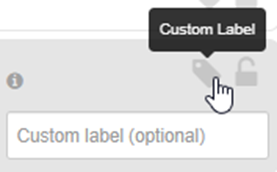
- Use Phone Manager's additional options to do the following:
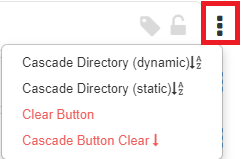
- Cascade Directory (dynamic)- Auto fills the button being assigned, and all subsequent buttons, with dynamic BLFs which update whenever the phone resyncs.
- Cascade Directory (static) - Auto fills the button being assigned, and all subsequent buttons, with static BLFs for the current directory entries.
- Clear Button - Deletes the button assignment and resets it to initial state.
- Cascade Button Clear - Deletes the button assignments for all subsequent buttons.
-
Reorder line keys by dragging the button ID circle and dropping it onto another spot.

-
Zoom in or out when viewing the phone image. Click Reset to return the phone image to its default view.

- Once done configuring the template, click either…

- Save - Save the change and have the phone apply any updates during its nightly update.
- Save as new template - Save the phone as a template to be applied to other phones.
- Save and resync - Save the phone and have the phone reboot itself to apply changes.
Update a Phone's Directory
- Click the Directory button.
 or
or 
✔ Doing so will open up the Phone Manager Directory modal.
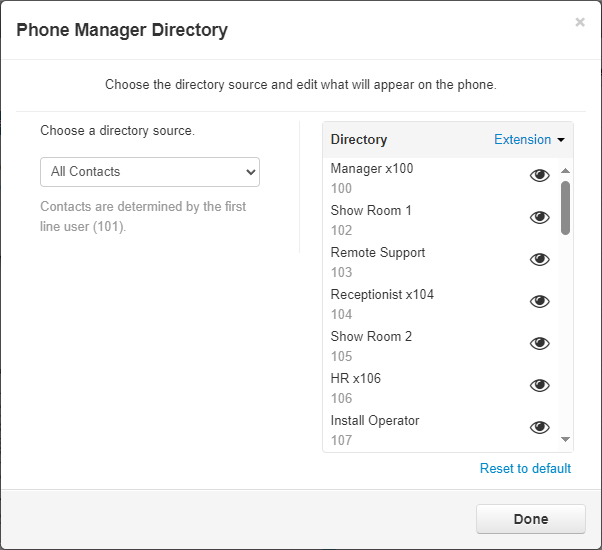
- In the Choose a directory source section, select where the phone's Directory should pull contacts from.
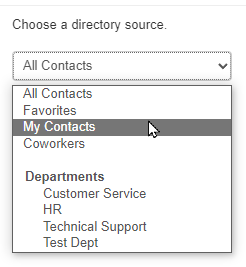
- In the Directory section, click Extension to select if the Directory should sort contacts by Extension, Last Name, or First Name.
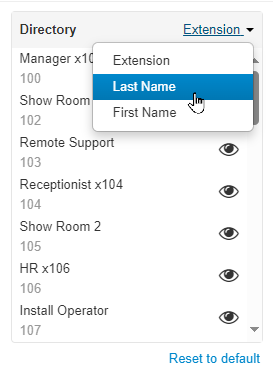
Quick Tip: Updating this will change how any BLFs that are added using the Cascade Directory (static) and Cascade Directory (dynamic) options are sorted.
- Click the Eye icon next to a contact to hide that user from the phone's Directory.
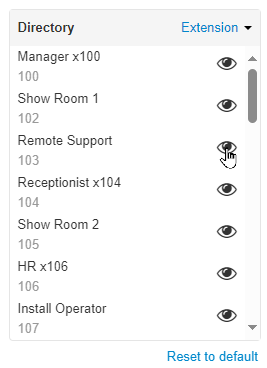
Quick Tip: Click the Eye icon again to show that contact in the phone's Directory.

To remove all of the changes you have made to the Directory, click Reset to default.

- Click the Done button once you are done with your changes.

Manage Templates
When there are a large number of phones in your Inventory, it may not be practical to edit the phones' configurations one-by-one. To make editing multiple phones easier, Configuration Templates can be used.
Add or Copy and Edit a Template
To view and edit a configuration template…
- Click the Phone Manager button.

Quick Tip: Alternatively, you can click the arrow
 and select Manage configuration templates.
and select Manage configuration templates.
- In the Phone Manager Launcher menu, click the Manage all templates hyperlink.

✔ Doing so will pull up the Phone Manager Configuration Templates menu.

- Add a template or Copy an existing template.
Add a New Template

1. In the Template Name box, type in a name for the new template.
2. In the Description box, type any notes about the template.
3. Using the Model drop-down box, select the phone model this template will be for.DANGER: The Model type of the template will need to match the model of the phones using this template.
Be sure to keep this in mind when creating a new Template for existing devices. The template will not be a selectable option if the Model of the phone does not match the model of the template.4. Click the Add button.

Copy a Template
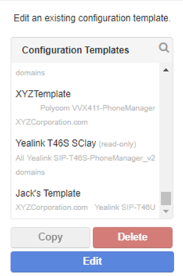
1. Click the Search icon
 and type in the name of a template or a specific phone model.
and type in the name of a template or a specific phone model.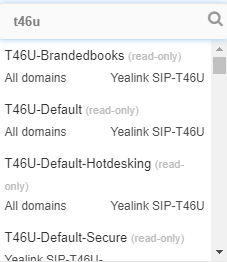
2. Select a template from the list.

3. Click the Copy button to create a version of this template that you can edit.

✔ Clicking Copy will pull up Phone Manager with the template's configurations displayed.

4. Click the Edit icon
 next to the template's name to rename the template to make the template easier to find later.
next to the template's name to rename the template to make the template easier to find later. 
5. Click the second Edit icon to adjust the description of the template.
to adjust the description of the template.
6. Customize this template to match what is needed for phones using this template.
7. Click the Save button.
Customize Your Template
When looking at a newly added or copied template, there are several ways you can personalize the template using the Phone Manager tool.
You can…
- Click the Directory button and use the Directory Source drop-down to select what contacts should be shown.
 or
or 
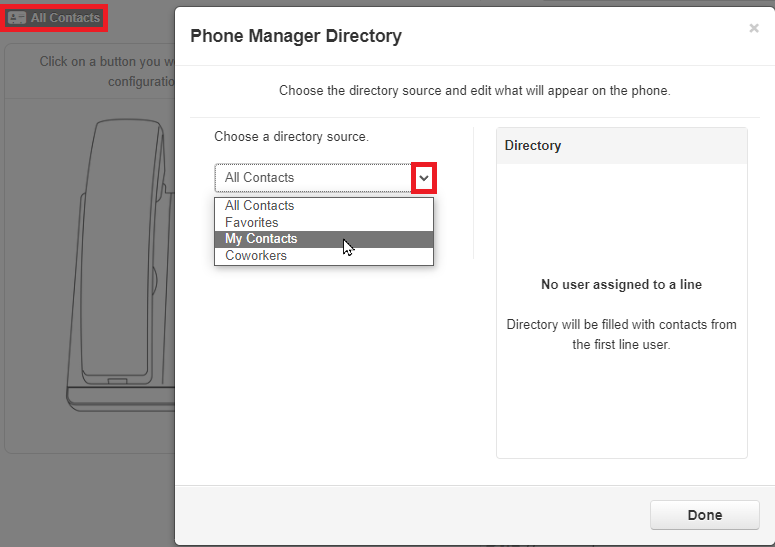
-
Add Features to your line keys to match your preferences.

Line Key Feature Options

Feature Description Line Appearance Adds a line registration to the device and acts as a channel of communication that allows for multiple calls to be handled at once. Some features, such as transfers and conferences, require at least two line appearance keys. Shared Line Appearance Adds a shared line registration that can be shared by multiple devices. User (BLF) Press this key to quickly call or transfer a call to a coworker. The light allows you to see the presence status of another extension. Speed Dial Press this key to quickly call or transfer a call to a specific destination. This key can be used to contact external telephone numbers and other internal users. Call Park Allows you to park and retrieve an active call, based on your Call Park Queues and Dial Translations. DTMF Use mid-call DTMF features such as star codes.
Note: This feature is not supported by Cisco and Poly IP devices.Queue Toggle Quickly toggle your queue availability status between Available and Unavailable.
Note: Indicator lights may not work on some devices.Timeframe Toggle Toggle a specific time frame on and off for your user. This timeframe must be on the Answering Rules of the user of the phone. Indicator lights may activate on applicable devices. Hot Desk This version of Hot Desking is not recommended.
If you would like to utilize a hot desk set up, please reach out to SpectrumVoIP’s Technical Support team.Queue Login Log into all call queues that you are assigned to. Queue Logout Log out of all call queues that you are assigned to. Move My Call Move a call that is currently active for your user to this device, such as from the SpectrumVoIP Mobile App, the StratusHUB desktop app, or the Stratus Web Phone. -
Lock line keys to prevent users from editing certain buttons while viewing their own phones.

- Add a Custom Label to name a line key.

- Use Phone Manager's additional options.
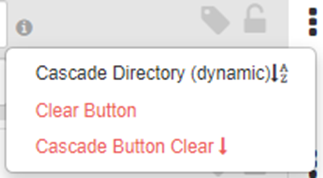
- Cascade Directory (static) - Auto fills the button being assigned, and all subsequent buttons, with static BLFs for the current directory entries.
- Cascade Directory (dynamic)- Auto fills the button being assigned, and all subsequent buttons, with dynamic BLFs which update whenever the phone resyncs.
- Clear Button - Deletes the button assignment and resets it to initial state.
- Cascade button clear - Deletes the button assignments for all subsequent buttons.
-
Reorder line keys by dragging the button ID circle and dropping it onto another spot.

-
Zoom in or out when viewing the phone image. Click Reset to return the phone image to its default view.

- Once done configuring the template, click Save (for new templates) or Save as new template (for copied templates).

Apply a Template
After a template has been made, it can be applied to phones on the account. This can be done to a single phone or multiple phones at a time.
Single Phone Template Update
- In the Phone Manager tab, click the Phone Manager icon
 next to the phone needing the change.
next to the phone needing the change.
- Click the Templates button and select a template from the dropdown.
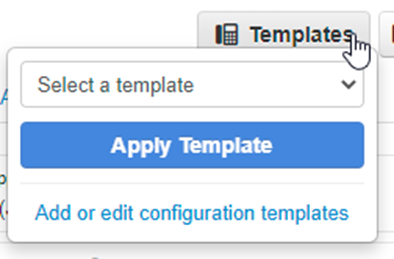
- Click the Apply Template button.

✔ You should see the buttons appear on the Phone Manager screen.
- Click Save and Resync to apply the template to the device.

Quick Tip: Alternatively, you can click the Save button to apply the changes in the portal and have the phone update later during its nightly update.
Bulk Update Selected Devices
Once you have created/edited a template, you can apply it to multiple phones.
To apply a template…
- In the Phone Hardware tab, click the check boxes to select the devices you wish to apply the template to.
- Click the Phone Manager drop-down arrow and select Apply a template to selected Devices.

✔ The Bulk Edit Phone Manger Templates menu will appear.
- In the Configuration Templates section, search for and select the template.
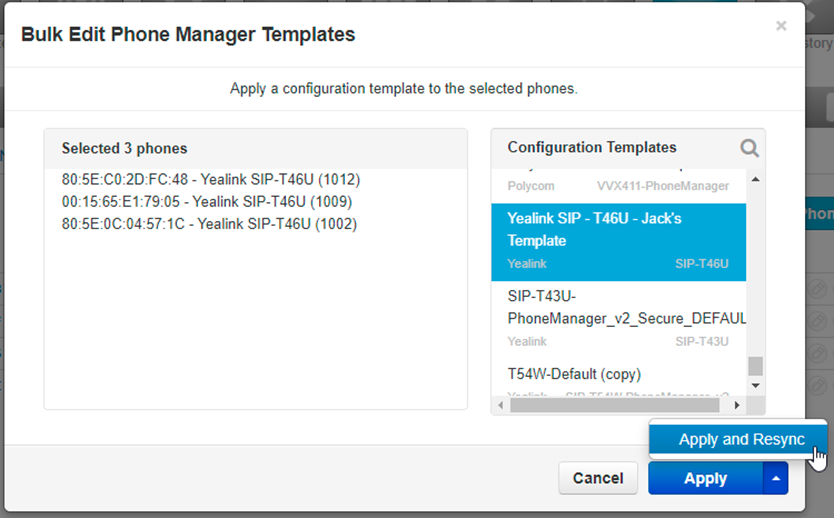
- Select Apply and Resync to apply the changes to both the portal and the phones.

Quick Tip: Alternatively, you can click the Apply button to apply the changes in the portal and have the phones update later during their nightly update.